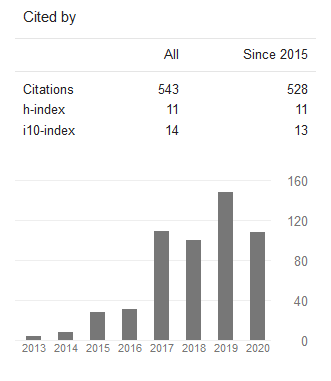Blackbox Testing on Virtual Reality Gamelan Saron Using Equivalence Partition Method
DOI:
https://doi.org/10.24002/jbi.v14i01.6606Keywords:
black box, equivalence partition, test case, error function, userAbstract
Testing is essential in application development because it helps identify and eliminate defects. One of the most used testing methods is Black Box testing, which involves deeply examining the application’s functionality without knowing its internal workings. The Equivalence Partition method is frequently used in Black Box testing to divide input values into groups and select test cases from each group. Potential errors can be identified by testing the available features with appropriate test cases, and future improvements can be made to ensure seamless application performance. In addition, testing results also serve as documentation and research for future development. By using this method, the developers of the VR Gamelan Saron application can ensure that its quality meets user expectations to improve its quality to provide an optimal user experience. In summary, proper testing is crucial in application development, and the Equivalence Partition method is an effective tool foridentifying and eliminating potential issues.
Keywords: black box, equivalence partition, test case, error function, user
References
Ahmad Triaji, “Pembuatan Aplikasi Augmented Reality Sebagai Media Pengenalan Alat Musik Gamelan Jawa Berbasis Android,” J. Multi Media dan IT, vol. 5, no. 2, Dec. 2021, doi: https://doi.org/10.46961/jommit.v5i2.446.
Pengelola Web Kemdikbud, “Gamelan Jadi Warisan Budaya Dunia, Mendikbudristek Sampaikan Apresiasi Kepada Pegiat Budaya ,” kemdikbud.go.id, Dec. 16, 2021.
Redaktur, “Jadi Warisan Budaya Dunia, Gamelan Yang Terlupakan Pewarisnya,” inijabar.com, Mar. 22, 2022.
E. Irmania, A. Trisiana, and C. Salsabila, “Upaya mengatasi pengaruh negatif budaya asing terhadap generasi muda di Indonesia,” Din. Sos. Budaya, vol. 23, no. 1, pp. 148–160, 2021, [Online]. Available: http://journals.usm.ac.id/index.php/jdsb.
Y. K. Dwivedi et al., “Metaverse beyond the hype: Multidisciplinary perspectives on emerging challenges, opportunities, and agenda for research, practice and policy,” Int. J. Inf. Manage., vol. 66, Oct. 2022, doi: 10.1016/j.ijinfomgt.2022.102542.
S. G. Fussell and D. Truong, “Using virtual reality for dynamic learning: an extended technology acceptance model,” Virtual Real., vol. 26, no. 1, pp. 249–267, Mar. 2022, doi: 10.1007/s10055-021-00554-x.
A. Kurniawan, A. Maulana, V. R. Sukma, W. Keumala, and A. Saifudin, “Jurnal Teknologi Sistem Informasi dan Aplikasi Pengujian Black Box pada Aplikasi Penjualan Berbasis Web Menggunakan Metode Equivalents Partitions (Studi Kasus: PT Arap Store),” vol. 3, no. 1, pp. 2654–4229, 2020, [Online]. Available: http://openjournal.unpam.ac.id/index.php/JTSI50
U. Nugraha and T. Sianturi, “Blackbox Testing On E-Commerce System Web-Based Evermos (Feature: Registration Experiment & Revamp),” 2021.
D. Yulistyanti, T. Y. Akhirina, T. Afrizal, A. Paramita, and N. Farkhatin, “Testing Learning Media for English Learning Applications Using BlackBox Testing Based on Equivalence Partitions,” Scope J. English Lang. Teach., vol. 6, no. 2, p. 73, 2022, doi:10.30998/scope.v6i2.12845.
S. Thapliyal and R. Bahuguna, “A Newly Proposed Ambidextrous Software Testing Model Based on Conventional Black Box Testing Strategy Using the Applications of Gaussian Distribution,” Int. Res. J. Innov. Eng. Technol., vol. 5, no. 8, pp. 94–101, 2021, doi: 10.47001/IRJIET/2021.508016.
M. Syah Anwar Kesuma Jaya, P. Gumilang, Y. Philipus Andersen, and dan Teti Desyani, “Pengujian Black Box pada Aplikasi Sistem Penunjang Keputusan Seleksi Calon Pegawai Negeri Sipil Menggunakan Teknik Equivalence Partitions,” vol. 4, no. 4, pp. 2622–4615, 2019, [Online]. Available: http://openjournal.unpam.ac.id/index.php/informatika
B. I. Fox and B. G. Felkey, “Virtual reality and pharmacy: Opportunities and challenges,” Hosp. Pharm., vol. 52, no. 2, pp. 160–161, 2017, doi: 10.1310/hpj5202-160.
J. Martín-Gutiérrez, C. E. Mora, B. Añorbe-Díaz, and A. González-Marrero, “Virtual technologies trends in education,” Eurasia J. Math. Sci. Technol. Educ., vol. 13, no. 2, pp. 469–486, 2017, doi: 10.12973/eurasia.2017.00626a.
G. YILDIRIM, M. ELBAN, and S. YILDIRIM, “Analysis of Use of Virtual Reality Technologies in History Education: A Case Study,” Asian J. Educ. Train., vol. 4, no. 2, pp. 62–69, 2018, doi: 10.20448/journal.522.2018.42.62.69.
M. A. Jamil, M. Arif, N. S. A. Abubakar, and A. Ahmad, “Software testing techniques: A literature review,” Proc. - 6th Int. Conf. Inf. Commun. Technol. Muslim World, ICT4M 2016, no. November, pp. 177–182, 2017, doi: 10.1109/ICT4M.2016.40.
M. Albarka Umar and C. Zhanfang, “A Comparative Study of Dynamic Software Testing Techniques,” Int. J. Adv. Netw. Appl., pp. 4575–4584, 2020.
Meiselino Ansfridus, “Implementasi Black Box Testing pada Sistem Techno Expertise Academy (TEA) (Studi Kasus: Astra Credit Companies)," pp. 16-17, Nov. 2021.
Downloads
Published
Issue
Section
License

This work is licensed under a Creative Commons Attribution-ShareAlike 4.0 International License.
Copyright of this journal is assigned to Jurnal Buana Informatika as the journal publisher by the knowledge of author, whilst the moral right of the publication belongs to author. Every printed and electronic publications are open access for educational purposes, research, and library. The editorial board is not responsible for copyright violation to the other than them aims mentioned before. The reproduction of any part of this journal (printed or online) will be allowed only with a written permission from Jurnal Buana Informatika.
This work is licensed under a Creative Commons Attribution-ShareAlike 4.0 International License.










